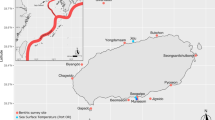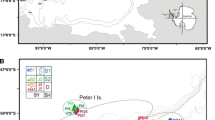Abstract
The present study was carried out in Palaeochori Bay, south eastern coast of Milos, where outflow of hot gas bubbles and hydrothermal water seepage was observed. The study tests hypotheses about relationships between seawater temperature and species with warm-water affinities in areas close to shallow-water vents. We predicted that if temperature plays a major role in influencing abundance of species with warm-water affinities, then there should be more thermophilous species in areas with higher seawater temperature. Time series of seawater temperature were recorded in Palaeochori Bay and Pollonia Bay where hot emission was not observed. Temperature, water pressure and conductivity were measured every 30 min from 19 June 1996 to 16 June 1997. Fourteen qualitative samples of benthic flora were collected by SCUBA diving in six rocky sites. Photosamples of benthic assemblages were collected using an UW camera equipped with a wide-angle lens (15 mm) and an electronic flash unit. A constant area of 0.7 m2 was sampled. Quantitative estimates of abundance of algal species were performed as percent cover. This paper shows that patterns of fluctuation in seawater temperature in Palaeochori were different from the control where no venting was found. In Palaeochori, algal assemblages were dominated by species with warm-water affinities that were not found elsewhere. These results are consistent with the hypothesis that temperature plays a major role in influencing abundance of species with warm-water affinities. According to our results, hydrothermal vents are potential oases that experience biological-physical coupling not yet clearly understood. They are important in affecting migration of alloctonous thermophilous species suggesting a possible role of vent areas as stepping stones for species migration.
Similar content being viewed by others
References
Aliani, S. & R. Meloni, 1999. Dispersal strategies of benthic species and water current variability in the Corsica Channel (Western Mediterranean). Sci. mar. 63: 137–145.
Aliani, S., L. Amici, P. R. Dando & R. Meloni, 1998. Time series of water pressure and bottom temperature in a marine shallow water hydrothermal vent of Milos Island (Aegean sea): preliminary results. Rapp. Comm. Int. Mèr Médit. 35: 46–47.
Astraldi, M., C. N. Bianchi, G. P. Gasparini & C. Morri, 1995. Climatic fluctuations, current variability and marine species distribution: a case study in the Ligurian Sea (North-Western Mediterranean). Oceanol. Acta 18: 139–149.
Athanasiadis, A., 1987. A survey of the seaweeds of the Aegean Sea with taxonomic studies on species of the tribe Antithamnieae (Rhodophyta). University of Gothenburg, Sweden. 174 pp.
Barry, J. P., H. G. Greene, D. L. Orange, C. H. Baxter, B. H. Robison, R. E. Kochevar, J. W. Nybakken, D. L. Reed & C. M. McHugh, 1996. Biologic and geologic characteristics of cold seeps in Monterey Bay, California. Deep Sea Res. 43: 1739–1762.
Bath, M., 1983. The seismology of Greece. Techtonophysics 98: 168–208.
Boscolo, R. & H. Bryden, 2001. Causes of long-term changes in Aegean deep water. Oceanol. Acta 24: 519–527.
Boudouresque, C. F. & M. Verlaque, 2002. Biological pollution in the Mediterranean Sea: invasive versus introduced macrophytes. Mar. Poll. Bull. 44: 32–38.
Cerrano, C., G. Bavestrello, C. N. Bianchi, R. Cattaneo-Vietti, S. Bava, C. Morganti, P. Picco, G. P. Sara, S. Schiapparelli, A. Siccardi & F. Sponga, 2000. A catastrophic mass-mortality episode of gorgonians and other organisms in the Ligurian Sea (North-western Mediterranean), summer 1999. Ecol. Lett. 3: 284–293.
Chevaldonné, P., D. Desbruyères & M. Le Haitre, 1991. Time series of temperature from three deep-sea hydrothermal vent sites. Deep Sea Res. 38: 1417–1430.
Cocito, S., C. N. Bianchi, C. Morri & A. Peirano, 2000. First survey of sessile communities on subtidal rocks area with hydrothermal vents: Milos island, Agean Sea. Hydrobiologia 426: 113–121.
Dando, P. R., J. A. Hughes, Y. Leah, S. J. Niven, R. J. Taylor & C. Smith, 1995. Gas venting rates from submarine hydrothermal areas around the island of Milos, Hellenic Volcanic Arc. Cont. Sh. Res. 15: 913–929.
Gamenick, L., M. Abbiati & O. Giere, 1998. Field distribution and sulphide tollerance of Capitella capitata (Annelida: Polychaeta) around shallow water hydrothermal vents off Milos (Aegean Sea). A new sibling species? Mar. Biol. 130: 447–453.
Johnson, K. S., J. J. Childress & C. L. Beehler, 1988. Shortterm temperature variability in the Rose Garden hydrothermal vent field: an unstable deep-sea environment. Deep Sea Res. 35: 1711–1721.
Makropoulos, C. & P. W. Burton, 1984. Greek tectonics seismicity. Techtonophysics 106: 275–304.
Mayhoub, H. & C. Billard, 1991. Contribution à la connaissance d'un Stypopodium (Dictyotales, Phaeophyceae) installé récemment sur les côtes syriennes. Cryptog. Algol. 12: 125–136.
Morri, C., F. Cinelli & C. N. Bianchi, 1994. Sessile epifauna gigantism an a submarine cave with sulphur springs. Cave Diving 6: 4–9.
Morri, C., C. N. Bianchi, S. Cocito, A. Peirano, A. M. De Biasi, S. Aliani, M. Pansini, M. Boyer, F. Ferdeghini, M. Pestarino & P. Dando, 1999. Biodiversity of marine sessile epifauna at an Aegean island subject to hydrothermal activity: Milos, Eastern Mediterranean Sea. Mar. Biol. 135: 729–739.
Pansini, M., C. Morri & C. N. Bianchi, 2000. The sponge community of a subtidal area with hydrothermal vents: Milos Island, Aegean Sea. Estuar. coast shelf Sc. 51: 627–635.
Roether, W., B. Manca, B. Klein, D. Bregant, D. Georgopulos, V. Kovacecic & A. Lucchetta, 1996. Recent changes in Eastern Mediterranean deep water. Science 227: 333.
Ruiz, G. M., P. W. Fofonoff, J. T. Carlton, M. J. Wonham & A. H. Hines, 2000. Invasion of coastal marine communities in north America: apparent patterns, processes, and biases. Ann. Rev. Ecol. Syst. 31: 481–531.
Sartoni, G. & A. M. De Biasi, 1999. A survey of the marine algae of Milos Island, Greece. Cryptog. Algol 20: 271–283.
Tarasov, V. G., A. V. Gebruk, V. M. Shulkin, G. M. Kamenev, V. I. Faldeev, V. N. Kosmynin, V. V. Malakhov, D. A. Starynin & A. I. Obzhirov, 1999. Effect of shallow water hydrothermal venting on the biota of Matupi Harbour (Rabaul Caldera, Ner Britain Island, Papua New Guinea). Cont. Shelf. Res. 19: 79–116.
Thiermann, F., I. Akoumianaki, A. Huges & O. Giere, 1997. Benthic fauna of a shallow water gashydrothermal vent area in the Aegean Sea (Milos. Greece). Mar. Biol. 128: 149–159.
Thiermann, F., R. Windoffer & O. Giere, 1994. Selected meiofauna around shallow water hydrothermal vents off Milos (Greece): ecological and ultrastuctural aspects. Vie Milieu 44: 215–226.
Tunnicliffe, V., J. F. Garrett & P. H. Johnson, 1990. Physical and biological factors affecting the behaviour and mortality of hydrothermal vent tubeworms (vestimentiferans). Deep Sea Res. 37: 103–125.
Verlaque, M., 1994. Inventaire des plantes introduites en Méditerranée: origines et répercussions sur l'environnement et les activités humaines. Oceanol. Acta 17: 1–23.
Verlaque, M. & C. F. Boudouresque, 1991. Stypopodium schimperi (Buchinger ex Kützing) Verlaque et Boudouresque comb. nov. (Dictyotales, Fucophyceae), algue de Mer Rouge récemment apparue en Méditerranée. Cryptog. Algol. 12: 195–211.
Author information
Authors and Affiliations
Rights and permissions
About this article
Cite this article
De Biasi, A.M., Aliani, S. Shallow-water hydrothermal vents in the Mediterranean sea: stepping stones for Lessepsian migration?. Hydrobiologia 503, 37–44 (2003). https://doi.org/10.1023/B:HYDR.0000008484.91786.e8
Issue Date:
DOI: https://doi.org/10.1023/B:HYDR.0000008484.91786.e8




